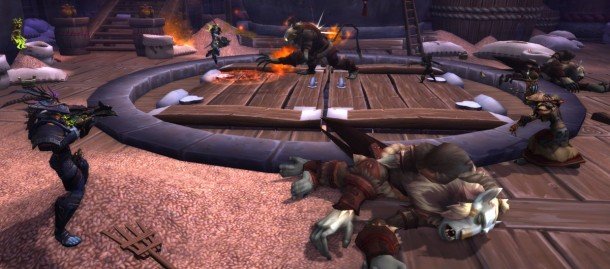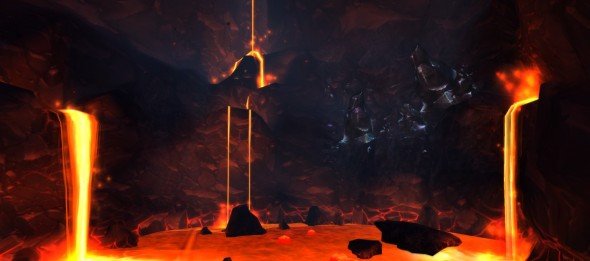World of Warcraft: Mists of Pandaria PVP guide

The greater part of Mists of Pandaria is taken up with new ways to quest, collect and compete in the endgame. The expansion's major additions for PVP players will be a single, as-yet-unseen new arena and two battlegrounds - Silvershard Mine and Temple of Kotmogu. Both introduce new objectives to competitive play that should add a touch of variety to your ganking sessions.
Organised teams have always done well in WoW's battlegrounds, but the new rulesets make having a plan more important than ever. We've taken a deeper look at the new mechanics to figure out what effect they'll have on the balance of World of Warcraft's PVP, and how you should approach each new battleground when you get your hands on the expansion.
Silvershard Mine
The comparison that immediately springs to mind is Team Fortress 2's payload mode, but Silvershard Mine doesn't alternate between attack and defense. Instead, three carts move simultaneously from the centre of the map to depots that lie along its outer edges. Bunching up players around the cart captures it for your side, and being in control of a cart when it reaches a depot earns your team a point. It's a ten-a-side match, and the first to three points wins.
The fact that everyone is scrambling for the same carts will make balancing offense and defence the key to success, with a little room for flexibility. Against an aggressive enemy, locking down one cart and harassing the remaining two may be preferable to trying to defend too much and losing everything.
Then there are other complicating factors. Being able to switch carts between tracks makes for interesting tactical decisions. Losing hold of a cart? Switch it on to a longer route and abandon it entirely. Confident that you've got everything locked down? Send a vanguard to make sure the enemy can't derail you.
Of course, it doesn't matter who does the pushing as long as you're the team in control when the cart finally reaches a depot. As Josh points out , this is the ideal time for last minute switch-arounds and victories seized from the jaws of defeat. What's exciting about Silvershard Mine is the potential for all of these mechanics to suddenly shift the balance of power: teams will need to be adaptable to successfully respond to the array of things that can suddenly go wrong (or right.)
Having a mobile objective should prevent Silvershard Mine from descending into a standoff in the same way that Arathi Basin and Battle for Gilneas can - after all, it worked for Team Fortress 2.
The biggest gaming news, reviews and hardware deals
Keep up to date with the most important stories and the best deals, as picked by the PC Gamer team.

Temple of Kotmogu
The first Pandarian battleground is a different matter. In Temple of Kotmogu, both teams fight over an artifact that makes a single player bigger and more powerful while also increasingly reducing their damage resistance over time. As long as they retain control of the artifact, their team gains points, with bonuses based on where in the map you choose to make your stand.
Taking up arms in the exposed central courtyard earns five points, while holding the more sheltered plaza and temple grounds earns three points and one point respectively. Unlike Silvershard mine, teams will be on the offensive most of the time - either to capture the artifact, or reduce the enemy's ability to fight back. Trying to hide is unlikely to be effective: the carrier is huge, after all, and the rectangular arena provides fairly open lines of sight.
It'll therefore be important for players to balance the risk and reward of going all out on the offensive and trying to hold the middle ground versus taking a more moderate approach. Nominating a player to carry the artifact will also be a crucial decision: do you pass it off to a warrior in an attempt to mitigate the defense debuff, or do you ignore it entirely and create a super-powered mage who is even more of a glass cannon than usual?
Like Silvershard Mine, The Temple of Kotmogu is currently slated to be a 10 vs 10 battleground. By focusing attention on a single player, individual skill and tight group coordination will be more important than ever. Hopefully, this will highlight the strengths of WoW's complex class and build system - but it could also exacerbate the effect of any imbalances. With many classes receiving a substantial rethink in Mists of Pandaria, it's an issue worth paying close attention to.
Joining in 2011, Chris made his start with PC Gamer turning beautiful trees into magazines, first as a writer and later as deputy editor. Once PCG's reluctant MMO champion , his discovery of Dota 2 in 2012 led him to much darker, stranger places. In 2015, Chris became the editor of PC Gamer Pro, overseeing our online coverage of competitive gaming and esports. He left in 2017, and can be now found making games and recording the Crate & Crowbar podcast.


